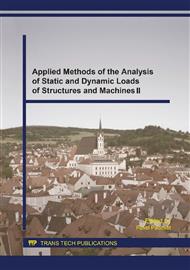[1]
M. Valcuende, F. Benito, C. Parra, I. Minano, Shrinkage of self-compacting concrete made with blast furnace slag as fine aggregate, Construction and Building Materials 76 (2015) 1–9.
DOI: 10.1016/j.conbuildmat.2014.11.029
Google Scholar
[2]
P. Reiterman, M. Jogl, V. Bäumelt, J. Seifrt, Development and mix design of HPC and UHPFRC, Advanced Materials Research 982 (2014) 130–135.
DOI: 10.4028/www.scientific.net/amr.982.130
Google Scholar
[3]
L. Laiblová, T. Vlach, A. Chira, M. Novotná, C. Fiala, M. Ženíšek, P. Hájek, Technical textiles as an innovative material for reinforcing of elements from high performance concretes (HPC), Advanced Materials Research 1054 (2014) 110–115.
DOI: 10.4028/www.scientific.net/amr.1054.110
Google Scholar
[4]
E. Vejmelková, M. Keppert, M. Ondráček, R. Černý, Effect of natural zeolite on the properties of high performance concrete, Cement, Wapno, Beton 3 (2013) 150–159.
Google Scholar
[5]
O. Holcapek, J. Litos, J. Zatloukal, Destructive and nondestructive characteristics of old concrete, Advanced Materials Research 1054 (2014) 243–247.
DOI: 10.4028/www.scientific.net/amr.1054.243
Google Scholar
[6]
P. Konvalinka, J. Litoš, D. Jandeková: Volume Changes of Cement Pastes Using Metakaolin, in: M. Růžička, K. Doubrava, Z. Horák (Eds. ), Proceedings oft he 50th Annual Conference on Experimental Stress Analysis (EAN 2012), Czech Technical University in Prague Faculty of Mechanical Engineering, Prague, 2012, ISBN 978-80-01-05060-6, pp.211-216.
DOI: 10.17973/mmsj.2022_10_2022120
Google Scholar
[7]
D. Kopkáně, L. Bodnárová, R. Hela, Restrained Shrinkage Ring Test on Polymer Fibres Treated in Cold Plasma Discharge, Applied Mechanics and Materials 464 (2014) 25-30.
DOI: 10.4028/www.scientific.net/amm.464.25
Google Scholar
[8]
Czech Standard CSN EN 196-1 Methods of testing cement – Part 1: Determination of strength, (2005).
Google Scholar
[9]
O. Holčapek, P. Reiterman, P. Konvalinka, Fracture characteristics of refractory composites containing metakaolin and ceramic fibers, Advances in Mechanical Engineering 7/3 (2015) 1-9.
DOI: 10.1177/1687814015573619
Google Scholar
[10]
F. Vogel, O. Holcapek, P. Konvalinka, Study of the strength development of the cement matrix for textile reinforced concrete, Advanced Materials Research 1054 (2014) 99–103.
DOI: 10.4028/www.scientific.net/amr.1054.99
Google Scholar
[11]
K. Polozhiy, J. A. Siddique, P. Reiterman, Influence of Plasticizer on Properties of Blended Cement Concrete, Materials Science Forum 824 (2015) 61-64.
DOI: 10.4028/www.scientific.net/msf.824.61
Google Scholar
[12]
P. Padevet, T. Otcovska, O. Zobal, Influence of fly ash type on material properties of cement paste, Advanced Materials Research 969 (2014) 212–217.
DOI: 10.4028/www.scientific.net/amr.969.212
Google Scholar
[13]
J. Zach, M. Sedlmajer, J. Hroudová, A. Nevařil, Technology of Concrete with Low Generation of Hydration Heat, Procedia Engineering 65 (2013) 296-301.
DOI: 10.1016/j.proeng.2013.09.046
Google Scholar


